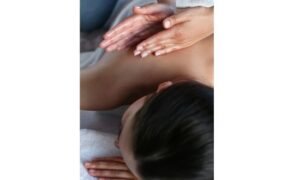Receiving a massage is a wonderful way to relax and relieve tension in your body. But sometimes, after a massage, you might feel a bit sore. This soreness after massage is a normal reaction that happens to many people. Here are 10 effective ways to relieve soreness after massage.
What Causes Soreness After Massage?
When you get a massage, your muscles and tissues are being manipulated and worked on, which can sometimes lead to a feeling of soreness afterward. Here are some reasons why this might happen:
- Muscle Work: During a massage, the therapist applies pressure and movements to your muscles. This can cause tiny damages to the muscle fibers, which is a normal part of the process for muscles to become stronger.
- Release of Toxins: The massage process might also release toxins that were stored in your muscles. When these toxins are let go, it could make you feel a bit sore as your body gets rid of them.
What Does Soreness after Massage Feel Like?
Soreness after massage can feel different for everyone. Some people might not feel sore at all, while others might experience varying degrees of discomfort. Common feelings might include:
- Muscle Tenderness: Your muscles might feel tender to the touch.
- Stiffness: You might feel stiff or less flexible in certain areas.
- Mild Pain: It could feel like mild pain or achiness in the muscles that were massaged.
Bruising After a Massage
- Possible Causes: Excessive pressure during massage, sensitive skin, or underlying health conditions may lead to bruising.
- Appearance and Timing: Bruises might show up within a day or two after a massage, often fading within a few days.
- Management: Use a cold compress, avoid pressure on the bruised area, and communicate discomfort with the therapist.
- When to Seek Help: Severe or persistent bruising accompanied by extreme pain or unusual symptoms warrants medical attention for evaluation.
10 Ways to Relieve Soreness After Massage
There are numerous effective ways to alleviate soreness after massage. Here are ten effective ways to relieve soreness after massage:
- Stay Hydrated:
Drink plenty of water before and after your massage. Hydration helps flush out toxins released during the massage and aids in muscle recovery. To keep track of your daily water intake use our accurate and user friendly water intake calculator.
- Gentle Stretching:
Engage in gentle stretching exercises to alleviate muscle tension, enhance flexibility, and improve blood circulation. Focus on areas that feel sore or tight.
- Heat Therapy:
Apply heat to soothe sore muscles. Enjoy a warm shower, use a heating pad, or take a bath with Epsom salt to relax tense muscles and increase blood flow.
- Cold Therapy:
Alternatively, use ice packs or take a cold bath to reduce inflammation and numb sore areas. Apply ice for short durations to avoid damaging the skin.
- Topical Treatments:
Utilize muscle rubs, CBD lotions, or essential oils known for their anti-inflammatory properties. Massage these topical treatments into sore muscles for relief.
- Herbal Remedies:
Use of natural remedies like turmeric, ginger or cinnamon can help to reduce soreness after massage because of their anti-inflammatory properties. You can take these as supplements or teas to help ease muscle soreness.
- Rest and Relaxation:
Give your body enough time to rest and allow your body to recover after a massage. This can be done by elevating your legs, practicing deep breathing, listening to calming music or by reading a good book.
- Professional Massage:
Try to schedule a follow-up massage with your therapist. A gentle follow-up massage might help alleviate residual soreness and improve overall comfort.
- Over-the-Counter Pain Relievers:
You can use over-the-counter pain medications like ibuprofen or acetaminophen to manage discomfort. Consult a healthcare professional for appropriate dosage and advice.
- Communicate with Your Therapist:
Communicate any concerns or areas of discomfort to your massage therapist before every massage session. They can adjust the pressure or focus on specific areas to minimize soreness after massage.
Different Massage Types
There are various types of massages. Each type of massage follows unique techniques which are focused on different aspects of well-being. Here are some popular types of massages:
- Swedish Massage:
Known as the most common and classic massage technique, Swedish massage focuses on gentle, flowing strokes combined with kneading and circular motions. It aims to relax the entire body, improve blood circulation, and relieve muscle tension.
- Deep Tissue Massage:
This massage technique involves applying firmer pressure to target deeper layers of muscles and connective tissues. It’s beneficial for chronic pain, muscle injuries, and improving posture by releasing tension in specific areas.
- Aromatherapy Massage:
Aromatherapy massage involves the use of essential oils extracted from plants to enhance the massage experience. The oils used in aroma therapy are known for their therapeutic properties. It helps in relaxation, stress reduction and mood enhancement.
- Hot Stone Massage:
During a hot stone massage, smooth, heated stones are placed on specific points on the body or used as tools to apply gentle pressure.
- Shiatsu Massage:
Originating from Japan, Shiatsu massage involves applying pressure to specific points on the body using fingers, palms, or thumbs. It aims to balance the body’s energy flow and alleviate tension while promoting relaxation.
- Thai Massage:
Thai massage combines yoga-like stretches, gentle rocking, and pressure point stimulation.
- Sports Massage:
Primarily designed for athletes, sports massage targets specific muscle groups related to sports activities. It helps to prevent injuries and improves flexibility. Moreover, it helps to enhances performance and aids in post-exercise recovery.
- Trigger Point Massage:
This type of massage focuses on tight areas within muscle tissue that can cause pain in other parts of the body. Applying pressure to these points helps in releasing tension and decreasing pain.
- Prenatal Massage:
This type of massage is for pregnant individuals. Prenatal massage aims to decrease the discomfort associated with pregnancy such as backaches, leg cramps and swelling. It’s performed with techniques which is safe for expecting mothers.
- Reflexology:
Reflexology focuses on applying pressure to specific points on the feet, hands, or ears that correspond to different organs and systems in the body.
When to Talk to Your Therapist?
Open communication with your massage therapist is vital. Discuss your concerns, preferred pressure and areas requiring special attention before and during the session. It’s crucial to notify your therapist about any medical conditions, injuries or discomfort during the massage to ensure a comfortable experience. It will also help to limit soreness after massage.
When to Seek Medical Help?
Here are the situations when it’s advisable to consult medical advice in case of soreness after massage:
- Persistent Pain or Discomfort: If significant pain or soreness doesn’t improve within a reasonable time frame post-massage.
- Unusual Symptoms or Reactions: Severe headaches, dizziness, nausea, or allergic reactions following a massage require medical attention.
- Underlying Health Conditions: For those with conditions like cancer, pregnancy, fractures, bleeding disorders, or severe osteoporosis, consulting a doctor before a massage is crucial.
- Uncertainty about Pain Source: Seek medical advice if unsure whether post-massage discomfort is treatment-related or due to an underlying issue.
- Specific Medication/Concerns: Consult a healthcare professional before massage if taking blood-thinning meds, having wounds, burns, or thrombocytopenia.
- Ongoing Pain/Conditions: Persistent neck or back pain, especially after massages, warrants a doctor’s evaluation for alternative treatment plans.
- Unusual Physical Reactions: Excessive bruising, swelling, or signs of infection after a massage should prompt seeking medical guidance.
- Concerns During Massage: If discomfort, sharp pain, or therapist pressure causes concern during the session, communicate immediately and consult a doctor if the issue persists or worsens.
The Bottom Line
Soreness after massage is a common reaction that many people experience. It happens because of the manipulation of muscles and tissues during the massage. Remember, it’s usually temporary and should go away on its own. You can manage soreness after massage by staying hydrated, taking care of your body and seeking help if needed.
Disclaimer
Content on this site is written with thorough research and keeping in mind the latest guidelines. However, no content on this site should substitute professional consultation.

Thank you for your sharing. I am worried that I lack creative ideas. It is your article that makes me full of hope. Thank you. But, I have a question, can you help me?
Thank you so much for your kind words! I’m glad you enjoyed my post. For any query feel free to contact me at allmedicainquiries@gmail.com